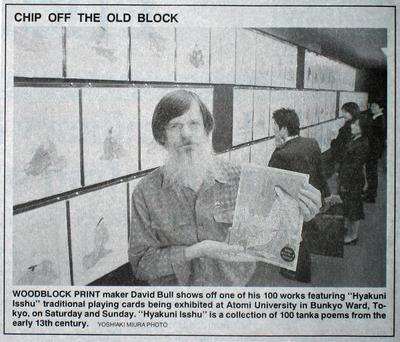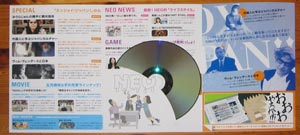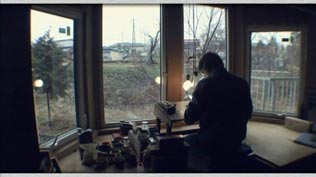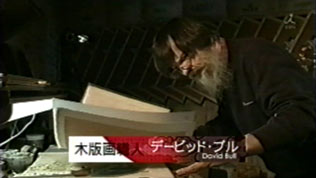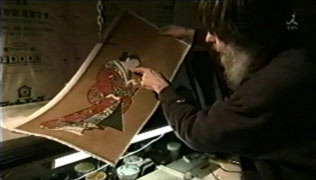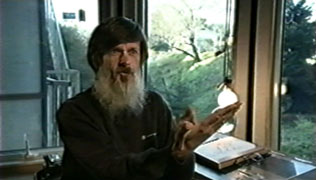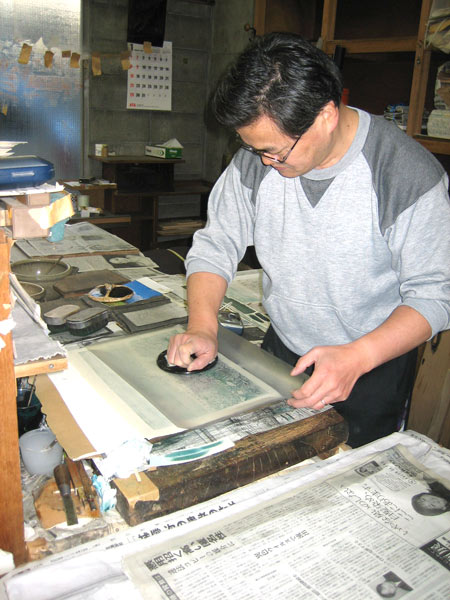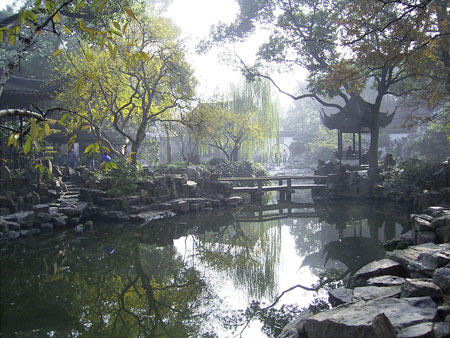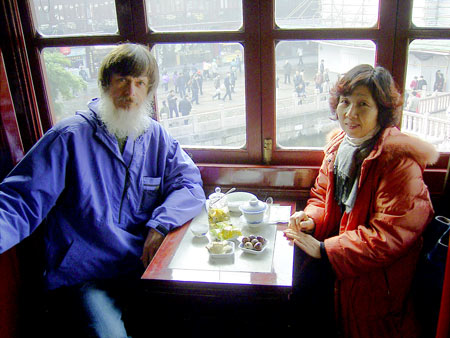The New Project
Whenever our family conversations turn to discussions of the 'good old days', my mother has a few stories about her 'children' she never tires of telling. It might be the story about my baby brother climbing a high ladder one day, or about how my sister used to dress the family cat in baby clothes and push it around in a buggy. When it comes to my turn, she likes to reminisce about the time I attended a pre-school in London, when I was four years old. The school was located a couple of stops away on the subway system, and she says that I went to school every morning on the train alone. She says that I insisted, "I want to do it by myself!"
Now a desire to 'do it by myself' of course isn't something peculiar to me; there is a standard joke for example, that men will never ask for directions, because they want to 'do it by myself'. But I do think that I have this 'bug' in a particularly strong version; many times in the early days of my printmaking, I would have been far better off to have looked for advice more often than I did - it would have saved me a lot of grief. But no, I want to 'do it by myself'.
Perhaps you can guess what I am getting at with this preamble. For nearly twenty years, I have been publishing sets of prints based on designs by other people. I have published every print, have carved every line of every block, and have printed every colour on every sheet ... but always the designs were taken from pre-existing work. Yes, for my next series, I am going to 'do it by myself' - it will be a series of original prints.
Let me tell you some details of what I have in mind ... a print series of course, but a print series with a very special difference! To 'double the pleasure' for the collectors, every print will be issued in combination with a chapter of what will become a complete book once the set is finished. In an equal partnership, the prints will illustrate the book, and the book will provide depth and background to the prints.
The Theme: 'My Solitudes'
Ever since childhood I have been interested in outdoor life, making frequent hiking and camping trips. In recent years I have explored areas near my Ome home, and have discovered three 'private' places to which I frequently return - one on a quiet river, one deep on a forested mountainside, and one on a deserted stretch of seacoast. In this series, the collectors will come along with me, as I return to these places with my camping gear - notebook and sketchbook in hand.
The complete series will consist of 12 prints, based on designs created during four visits to each location - once in each season. That would make a logical one-year project, but one month isn't enough time for all the work that will be necessary to create each print, so they will be issued at two month intervals, beginning in early summer of 2007, and running through to the spring of 2009.
What will we see in the prints? As you can imagine, we will see the beauty of these Japanese landscapes in all weathers and all seasons. What will we read in the book? Readers of my stories know that it is useless to predict where the 'thread' will go. While sitting on a peaceful river bank, I will see a bird fly overhead, and the story will fly away just as freely as the bird.
But the overall theme - for both prints and stories - will be established by the landscape, as we discover that around this vast metropolis of 35,000,000 people, it remains possible to find such peaceful and natural environments. That any of the 35,000,000 people living here could do the same things I have done - they too could watch the full moon rise over a silver sea, see the hawk dive for fish, or open their tent flap on a crisp winter morning to the enchanting sight of a fresh snowfall blanketing the woods ...
Series details: each book chapter will be issued as a separately bound volume (in traditional Japanese tied binding) with the woodblock print tipped into it. The chapters will stand by themselves as independent stories, but will make a coherent whole once the full set is complete. (The volumes will be bilingual English/Japanese). Each print/chapter will be 8,000 yen (in a set of 12 issued at two-month intervals for two years)
Once the series has proceeded far enough along to allow for accurate measurement, a wooden storage box in which to keep the set of 12 volumes will be offered.
***
Many of the collectors have been suggesting and requesting for years that I should produce some original work, but I have always resisted. I have hidden behind my knife and baren - tools with which I have become very comfortable over the years - and have flatly refused to consider such an idea. What I say next may seem to be a bit of a contradiction, because even as I write this I am still struggling with the extremely difficult printing of the large scroll print, but I think I have become somewhat complacent about my work in recent years. When I head downstairs into my workshop every day, I know what I will be doing, and I know how to do it. I am not bored, not by a long shot - the work is too difficult for that - but there is no question that I am in a kind of 'routine'.
Almost exactly twenty years ago, I was working in a music store in Canada, happy and productive, good at my job, but very much in a routine. We all know what happened; I gave my notice, brought my family to a new country, and carved out a new life. Nothing so dramatic will happen this time. I will still make prints, carving and printing every sheet, then sending them out to waiting collectors, as I have been doing for so many years. The only difference will be that now, at the beginning of each one, I will be faced with that very white, very empty, blank sheet of paper.
Last week, I asked my two daughters their opinion of this planned project. Their responses were interesting; here are two 'snips' from their correspondence:
"This is going to be fun to see!" and ...
"I don't know about this, Dad ..."
So it seems as though my 'fan club' is evenly divided on their confidence in my ability to pull this off. I hope that you too, will think that "this is going to be fun to see," and that you will consider entering a subscription to the series.
Thank you for your support for this adventure!



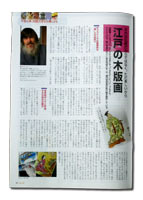 This magazine is well known in many places overseas, but is fairly new here in Japan - it is published for the benefit of the homeless, and is distributed by them outside train stations. They ran a feature on people working in the field of traditional crafts, and I was selected to be included.
This magazine is well known in many places overseas, but is fairly new here in Japan - it is published for the benefit of the homeless, and is distributed by them outside train stations. They ran a feature on people working in the field of traditional crafts, and I was selected to be included. 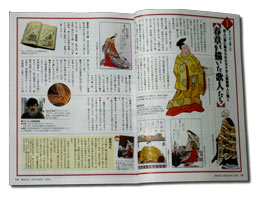 This is a general interest magazine produced by the national agricultural cooperative, to be sent to pension recipients. For their year-end issue, they did a feature on the Hyakunin Isshu, and included a nicely produced two-page story on my prints of the old poets.
This is a general interest magazine produced by the national agricultural cooperative, to be sent to pension recipients. For their year-end issue, they did a feature on the Hyakunin Isshu, and included a nicely produced two-page story on my prints of the old poets. I was a bit surprised when the editor for this magazine called me up and asked to talk. It is produced by an organization concerned with immigration affairs, and my first thought was a concern as to whether or not my residence paperwork was all in order! But I had nothing to worry about - they were simply featuring 'foreigners immersed in Japanese culture' in their monthly magazine, and wanted an interview!
I was a bit surprised when the editor for this magazine called me up and asked to talk. It is produced by an organization concerned with immigration affairs, and my first thought was a concern as to whether or not my residence paperwork was all in order! But I had nothing to worry about - they were simply featuring 'foreigners immersed in Japanese culture' in their monthly magazine, and wanted an interview! Although I was very well-known in Hamura, the town where I lived until about six years ago, I have a much lower profile here in Ome, my current city, mostly because I'm not constantly involved with community affairs with my children, as I was back in Hamura. But a local community paper did an interview with me earlier this year, so this is changing ...
Although I was very well-known in Hamura, the town where I lived until about six years ago, I have a much lower profile here in Ome, my current city, mostly because I'm not constantly involved with community affairs with my children, as I was back in Hamura. But a local community paper did an interview with me earlier this year, so this is changing ...